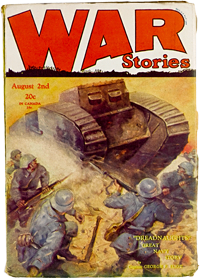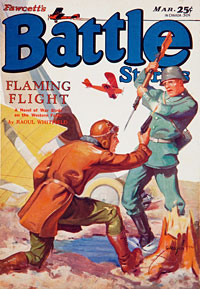
The July/August 1966 issue of The Pulp Era (#64), published by Lynn Hickman, included a reminiscence, by Donald A. Wollheim, of Dell Publishing‘s War Stories. Wollheim was a successful sf writer and editor, but here he writes about a time before he discovered science fiction.
Here’s an excerpt of his story in what let’s call a fanzine flashback:
The first magazine I ever bought strictly on my own — and kept on buying — was not a science fiction magazine nor a copy of Argosy or Weird Tales or some such magazine you might associate with my sub-sequent editorial and fannish career. It was the first magazine of a new trend in the ’20s (surely the height of the pulp days) — a trend due to boom incredibly for a few years and then fade away to nothing in the harsh times of the ’30s. The title of the magazine was War Stories and it had only to appear that first time, back, when was it, must have been 1923 or 1924, to catch my boyish eye.
I was then 9 or 10, still in elementary school, a reading type lad but going into a curious interlude. A devotee of fairy tales in my infant days (and I continued to read them and scattered early science fiction too, all during this new phase), I was also an ardent enthusiast for toy soldiers and war games played with them. This led to an early interest in warfare and soldiery — and hence the lurid title of this new magazine caught my eye and imagination solidly.
 The magazine’s logo rode on a white background across the top quarter of the cover. Over a silhouette of barbed wire and trenches, rose the word WAR in giant letters, with the word stories, also in red, tacked on underneath the letter R alone.
The magazine’s logo rode on a white background across the top quarter of the cover. Over a silhouette of barbed wire and trenches, rose the word WAR in giant letters, with the word stories, also in red, tacked on underneath the letter R alone.
And War Stories it was too. A magazine that rode a rising tide of nostalgia in ex-doughboys, back from France four or five years, and suddenly discovering that their brief adventure in the war was indeed the most exciting experience of their lives and far more intriguing than the dull hard routine of civilian life. This was the same nostalgia that made the American Legion — and looking over the old issues of the magazine that have come my way in later years, I can see the roots of the Legion spirit. It was all seeded there, in that period of reminiscence — when the debunking of war had not yet set in and the spirit of camaraderie still lingered on. This was a phase of literature reflected also in a spate of war novels in hard covers, mostly superficial junk, culminating in one that was lasting, realistic, and not superficial, (Erich Maria) Remarque‘s All Quiet on the Western Front (1929).
The stories in War Stories were not blood and guts — oh, there were passing references — but it was all heroism, glory, and, well, it made it all sort of fun somehow. Which was perfect for a toy-soldier enthusiast, aged 10, like me. The magazine however, was not catering to kids — it was surely directed to the young veterans, in their late 20s I’d guess. …
War Stories started a real boom. In about a year, Dell put out two companion magazines, War Novels which featured a novel an issue, and War Birds which was the first aviation story magazine (I think). Later they began other more specialized experiments like Navy Stories which was mildly successful. …
 Anyway, War Stories sold so well it went bi-weekly, as I said, but the other publishers were not asleep either. Fawcett (I think it was) brought out Battle Stories, which was pretty good too, though I remained loyal to the first one. And I vaguely recall many others, whose titles elude me (though I seem to think one was called Over The Top). War Birds brought about several aviation-story magazines all dealing primarily with World War I aviation.
Anyway, War Stories sold so well it went bi-weekly, as I said, but the other publishers were not asleep either. Fawcett (I think it was) brought out Battle Stories, which was pretty good too, though I remained loyal to the first one. And I vaguely recall many others, whose titles elude me (though I seem to think one was called Over The Top). War Birds brought about several aviation-story magazines all dealing primarily with World War I aviation.
It was the aviation stories that survived the drop-off of the war reading cycle. I guess a few years of nostalgic interest had to give way to grimmer reality as the ’20s passed into catastrophe, unemployment, and the rising shadow of new wars, and a new and even more fearsome Germany than the rather amiable villainous Boche of the First World War fictions. The war story boom died fast, I think, though my own reading had faded away rapidly when I discovered science fiction and Amazing Stories. By the mid-’30s, I think these magazines were all dead, though the aviation-story books were thriving quite well, right into the period of World War II.
But I still recall with fondness my pleasures of that 10-to-13-year-old period when I would haunt the stands for the next issues of War. The covers were in themselves often fascinating masterpieces in the horrible pulp tradition of the day.
Incidentally, I do recall that my father criticized my reading once (generally my parents did not try to influence what I read, for which they deserve thanks). He said that I was using too many damns and hells in my speech for a 10-year-old in a nice neighborhood. And that sure did come out of the pages of my favorite pulp — everybody in them yarns talked like that. (If they had talked like soldiers really talked, the magazines would have been banned altogether!) But the world was not ready for that type realism until a second world conflict had come and gone.
But, hell, do any of youse guys out there in No Man’s Land remember that damn magazine?
I have to admit that I haven’t read war pulps (other than aviation ones). Maybe it’s a genre I should take a look at.


Your comments